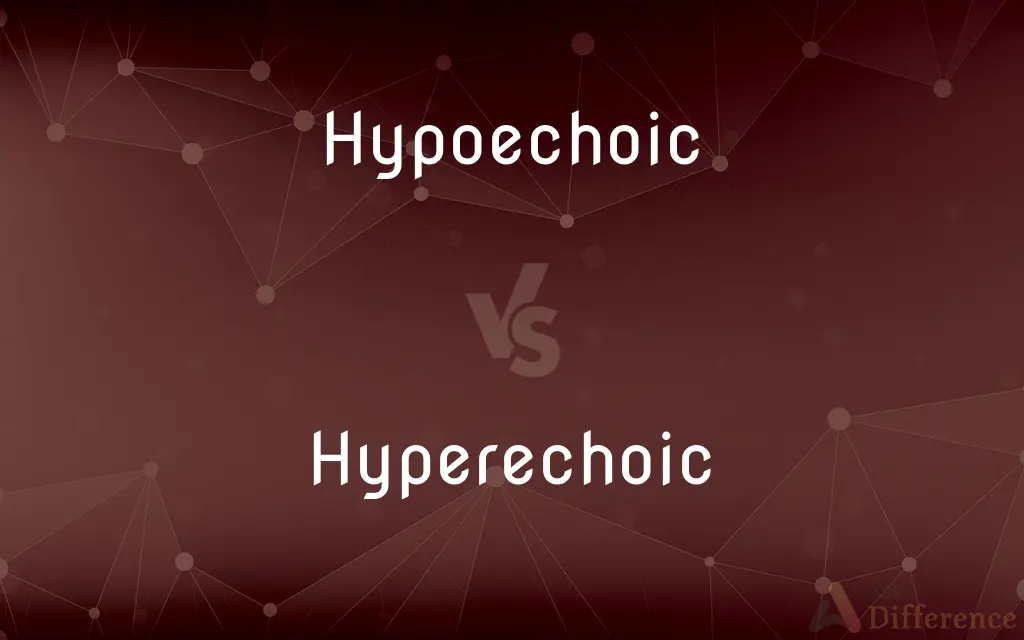Hypoechoic vs. Hyperechoic — What's the Difference?
Edited by Tayyaba Rehman — By Urooj Arif — Updated on May 2, 2024
Hypoechoic tissues appear darker on ultrasound due to low echogenicity, while hyperechoic tissues reflect more sound waves, appearing brighter.

Difference Between Hypoechoic and Hyperechoic
Table of Contents
ADVERTISEMENT
Key Differences
Hypoechoic tissues absorb more ultrasound waves, resulting in less reflection and a darker appearance on imaging. In contrast, hyperechoic tissues reflect more ultrasound waves back to the probe, creating a brighter image on the screen. This echogenicity affects how various tissues and abnormalities are visualized during ultrasound examinations.
In medical diagnostics, hypoechoic areas may indicate denser or fluid-filled tissues, such as cysts or solid tumors, while hyperechoic areas might suggest the presence of fatty tissues or calcifications. The distinction between hypoechoic and hyperechoic is crucial for accurate interpretation of ultrasound images.
Hypoechoic lesions are often further investigated due to their potential to represent more serious conditions, whereas hyperechoic features might be deemed less concerning depending on the context and organ involved.
The evaluation of muscle injuries also utilizes this terminology; damaged or inflamed muscles may appear hypoechoic due to swelling and fluid accumulation, while normal, healthy muscles often appear hyperechoic due to their fibrous structure.
Understanding the nuances between hypoechoic and hyperechoic textures helps medical professionals to tailor their diagnostic approach and management plans, enhancing patient care through precise imaging interpretations.
ADVERTISEMENT
Comparison Chart
Ultrasound Appearance
Darker image due to low reflection
Brighter image due to high reflection
Common Interpretations
Suggests denser or fluid-filled tissues
Indicates fatty or calcified tissues
Diagnostic Relevance
Often indicative of potentially serious conditions
Typically considered less concerning
Common in
Cysts, solid tumors
Fatty tissues, calcifications
Usage in Muscle Imaging
Shows damage or inflammation
Indicates normal, healthy tissue
Compare with Definitions
Hypoechoic
Pertaining to tissues that appear darker on an ultrasound due to their ability to absorb sound waves.
The tumor was hypoechoic, indicating it might be solid.
Hyperechoic
Higher echogenicity compared to surrounding tissues on an ultrasound.
The hyperechoic areas were easily distinguished from the darker, surrounding tissue.
Hypoechoic
Describing features in an ultrasound that reflect fewer sound waves back to the probe.
The hypoechoic area was suspicious for fluid accumulation.
Hyperechoic
Describing features in an ultrasound that send many sound waves back to the probe, enhancing brightness.
The hyperechoic nature of the tissue facilitated a clear diagnosis.
Hypoechoic
Often associated with pathological conditions in diagnostic imaging.
The hypoechoic mass required further evaluation through biopsy.
Hyperechoic
Pertaining to tissues that appear brighter on an ultrasound because they reflect more sound waves.
The liver lesions were hyperechoic, consistent with fatty infiltration.
Hypoechoic
Used in assessing the severity and nature of muscle injuries.
The muscle tear appeared hypoechoic on the ultrasound.
Hyperechoic
Often indicative of less concerning conditions like calcifications or fat.
Hyperechoic signals in the kidney suggested simple cysts.
Hypoechoic
Related to lower echogenicity compared to surrounding tissues.
The lesion was clearly defined as hypoechoic against the brighter background.
Hyperechoic
Useful in differentiating healthy tissues from damaged ones in imaging studies.
The healthy muscle fibers were hyperechoic compared to the inflamed areas.
Hypoechoic
Of low echogenicity.
Hyperechoic
Of high echogenicity.
Common Curiosities
Can hypoechoic tissues turn hyperechoic over time in ultrasound imaging?
Yes, changes in the nature of tissues, such as evolving calcifications or healing processes, can alter their echogenicity.
How does the orientation of the ultrasound probe affect the appearance of hypoechoic and hyperechoic areas?
The angle and pressure of the probe can influence how sound waves are reflected, potentially altering the perceived echogenicity of a structure.
Are hypoechoic features more challenging to detect on ultrasound than hyperechoic features?
Hypoechoic features can be more challenging to detect, especially if they are surrounded by other dark tissues.
What does hypoechoic mean on an ultrasound?
It means the tissue appears darker because it absorbs more sound waves.
What are common medical conditions associated with hypoechoic tissues?
Common conditions include tumors, cysts, and areas of inflammation.
What are common medical conditions associated with hyperechoic tissues?
Conditions such as fatty liver, calcifications, and fibrous tissues are typically hyperechoic.
Why is echogenicity important in prenatal ultrasounds?
Echogenicity helps differentiate between various fetal tissues and structures, assisting in the assessment of fetal health and development.
How do hypoechoic and hyperechoic features help in diagnosing conditions?
They help in distinguishing different types of tissues and pathologies, which aids in diagnosis and treatment planning.
Are hypoechoic areas always indicative of a serious condition?
Not always, but they often warrant further investigation to determine the underlying cause.
Can both hypoechoic and hyperechoic features appear in the same ultrasound?
Yes, many ultrasounds show a mix of hypoechoic and hyperechoic features, depending on the tissues and conditions present.
What does hyperechoic mean on an ultrasound?
It indicates that the tissue reflects more sound waves, making it appear brighter on the screen.
Share Your Discovery

Previous Comparison
Takeover vs. Acquisition
Next Comparison
Doctrinaire vs. DoctrineAuthor Spotlight
Written by
Urooj ArifUrooj is a skilled content writer at Ask Difference, known for her exceptional ability to simplify complex topics into engaging and informative content. With a passion for research and a flair for clear, concise writing, she consistently delivers articles that resonate with our diverse audience.
Edited by
Tayyaba RehmanTayyaba Rehman is a distinguished writer, currently serving as a primary contributor to askdifference.com. As a researcher in semantics and etymology, Tayyaba's passion for the complexity of languages and their distinctions has found a perfect home on the platform. Tayyaba delves into the intricacies of language, distinguishing between commonly confused words and phrases, thereby providing clarity for readers worldwide.












































